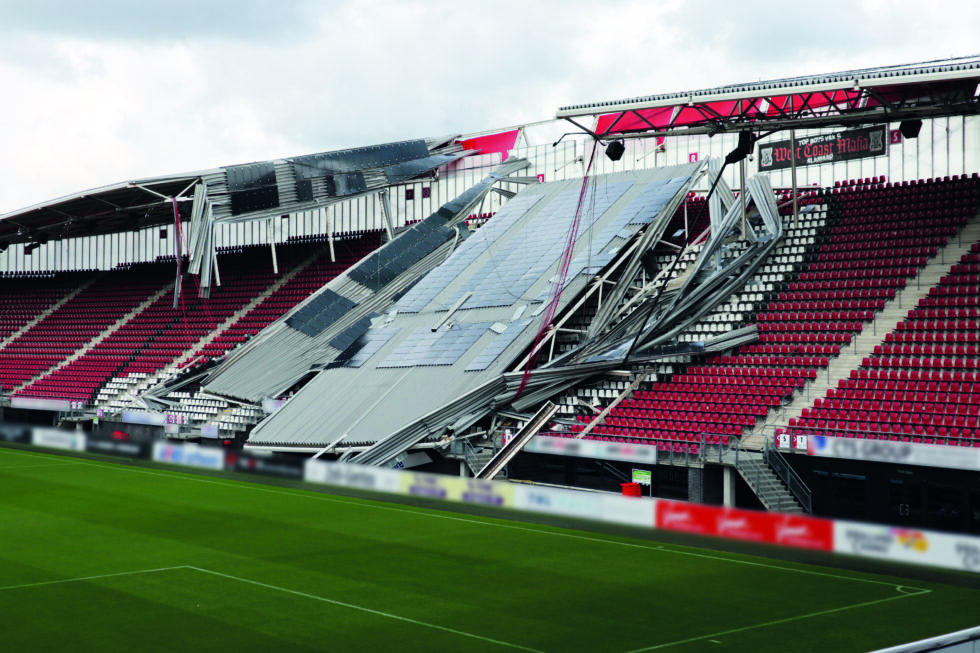
Hidden defects? Lessons learned from the collapsed roof of the AZ stadium
On Saturday 10 August 2019, part of the grandstand roof at the AZ stadium in Alkmaar collapsed. No audience was present at the moment of the collapse. At the time, the stadium had been in use for thirteen years. This occurrence led the Dutch Safety Board to examine how the structural safety of buildings is guaranteed during their use. This investigation report considers the causes of the occurrence at the AZ stadium and potential lessons to be learned for the structural safety of other buildings visited by large numbers of people.
Dutch Safety Board recommends annual technical inspections for large public buildings
Weakened welding joint
On Saturday, 10 August 2019, part of the grandstand roof of the AZ football stadium in the city of Alkmaar collapsed. At the time, the stadium had been in use for thirteen years. The Dutch Safety Board’s research shows that the steel roof construction did not meet the structural requirements when the stadium was completed. Within a few years, a crack appeared in one of the welding joints. During the time in which the stadium was in use, no thorough technical evaluations of the condition of the roof joints were conducted. As a result, it went unnoticed that one of the welding joints was growing increasingly weak. The roof eventually collapsed under a load which was far lower than the load which the structure was designed to withstand. During its investigation, the Dutch Safety Board therefore issued an interim warning for the welding joints in the remaining sections of the stadium’s roof in August of 2019.
Sixty incidents in 20 years
The investigation shows that the collapse at the AZ stadium is not an isolated incident. An inventory carried out by the Board has found that serious structural defects in more than 60 buildings have come to light over the past 20 years. This is not the Board’s first investigation as a result of an incident related to the construction industry: in 2017 it investigated the collapsed car park at Eindhoven Airport, in 2011 it looked into the collapsed roof of the Grolsch Veste stadium in Enschede and in 2010 it conducted an inquiry following the collapse of the concrete floor of B’Tower in Rotterdam. Following the investigation into the collapse of the car park in Eindhoven, the construction industry drew up an action plan to improve structural safety checks during the design and construction phases of buildings. However, once a building has been taken into use, such checks tend to fall by the wayside.
Responsibility
Building owners are responsible for the structural safety of their properties, but the law does not prescribe how this should be monitored. When a building is in active use, structural safety incidents can have major consequences for the people inside. Jeroen Dijsselbloem: “The users of a public building must be assured of the building’s safety and soundness. This requires building owners to be alert to the structural safety of their buildings.” That is why the Board recommends that the Minister of the Interior impose a legal obligation on owners of publicly accessible buildings to commission periodic structural safety inspections.
Recommendations
To the Minister of the Interior and Kingdom Relations:
1. Introduce a statutory requirement for public access buildings in consequence class 37 according to which the owners must carry out periodic investigations into the structural safety of the building and take any measures necessary to improve the structural safety.
- Have this periodic investigation undertaken by an independent certified expert.
- Ensure that the scope and frequency of the investigation are proportional to the potential seriousness in terms of risk to humans.
- Grant a role to municipal authorities in ensuring compliance with this statutory obligation.
- Specify that with each change of ownership, building owners must pass on the complete building file including reports of inspections, assessments and possible corrective measures, to the new owner.
- Include experience acquired abroad with guidelines for sporting accommodations (United Kingdom) and the periodic assessment of constructions (Germany).
2. In advance of the statutory obligation - issue a guideline to owners of buildings in consequence class 3 for the periodic assessment of structural safety, with an indication of the scope and frequency of the investigation.
- As an example for this guideline, make use of the Protocol for Assessing Structural Safety of Professional Football Stadiums.
To the parties in the TOPoverleg Veiligheid (Bouwend Nederland, the Forum for Commissioning Parties in the construction sector, VNconstructeurs, Governance Code Safety in Construction, Koninklijke NLingenieurs):
3. Ensure that the lessons learned from the collapse of the grandstand roof at the AZ stadium are included in your recently launched action plan aimed at structurally improving safety in the construction sector. In particular, focus attention on:
- Quality control for the construction of and maintenance on the structures of buildings used by large numbers of people (NEN-EN 1990 consequence class 3);
- Issuing, upon handover of a building to the owners, a carefully compiled and complete building file, including instructions and points for attention for use, periodic inspection and preventive maintenance;
- A system for recording and analysing occurrences relating to structural safety with the aim of learning lessons from those occurrences. It is essential that the resultant lessons for construction and use be actively distributed among parties in the construction sector and among building owners. Consider joining international initiatives such as CROSS International.
To the KNVB:
4. In advance of the statutory obligation as outlined in recommendation 1, encourage all licence holders to comply within the shortest possible timeframe with the Protocol for Assessing Structural Safety in Professional Football Stadiums.
Recommendations
Related news
-
 Persbericht:
Persbericht:Dutch Safety Board recommends annual technical inspections for large public buildings
- Structural safety
